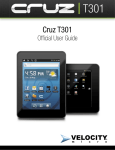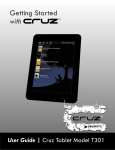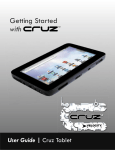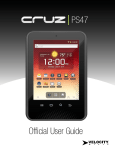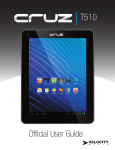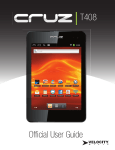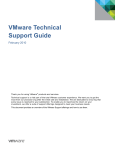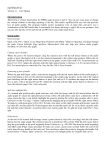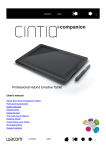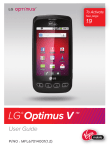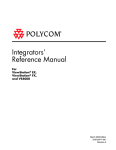Download Velocity Cruz T103 User guide
Transcript
Official User Guide CONTROL Thanks for Choosing Velocity! Thank you for purchasing a Velocity Micro CRUZ Tablet! We appreciate your business and know you’ll love your brand new multimedia device. This guide is intended to help you with initial setup of your device and to familiarize you with the Android operating system. Stay Up To Date! For the latest updates, news, giveaways, downloads, and support tips, be sure to follow CRUZ on facebook and twitter! Go to www.cruzreader.com for details! Also be sure to check out our Blog at www.cruzreader.com/CruzBlog Registration Before we get started, we recommend that you register your CRUZ Tablet. This allows you to get the most out of our CRUZ technical support. To register your product, please visit: www.cruzreader.com/support Table of Contents I. Getting Started 4-7 II. Hand Gestures 8-9 III. Your Home Screen IV. Adding Widgets To Your Home Screen V. Connecting to Wi-Fi 10-11 12 13-14 VI. Email Setup 15 VII. Saving Battery Life 16 VIII. SD Cards 17 IX. Device Storage and ASTRO 18-19 X. Transferring Files 20-22 XI. File Formats 23 XII. Preloaded Apps 24-25 XIII. Buying eBooks 26-27 XIV. Reading 3rd Party eBooks XV. Playing Media XVI. Flash and Youtube XVII. Installing Apps 28 29-30 31 32-33 XVIII. System Requirements 34 XIX. Open Source License 35 XX. Cruz Support and Registration 36 XXI. Contact Info 37 I. Getting Started Device Exterior: A B C D E F G 4 H I J K I. Getting Started (cont’d) A. Status Bar A white strip along the top of the screen displaying alerts, Wi-Fi strength, battery life, and the current time. B. Widget Area Your Home-screen has a designated area for widgets, which are basically “applications” that have functionality and accessibility directly from your home-screen. There are several preinstalled widgets on your CRUZ Tablet, such as a calendar and an analog clock, but you can download several others. To add a widget to your home-screen, press and hold on an empty space on the home-screen. Follow the on-screen instructions to add a widget. You can tap, hold, and drag to position the widget on your screen in the desired location. C. Apps Your Home-screen is very much like the “desktop” on a computer. You have a total of 5 customizable home-screens on your device. To shift screens, either slide your finger left/ right, or tap the small grey bullets in the bottom left and right of the home-screen. D. Nav Bar The Nav Bar is a semi-transparent 3-button bar at the bottom of the home screen. From left to right, the buttons are: “Gallery,” “App Panel,” and “Web Browser.” The Gallery button opens the primary image and video viewer application. The App Panel button displays all installed Applications. The Web Browser button brings up a new internet browser window. E. Quicklaunch Buttons These buttons are located outside the touch screen and control some of the most common functions in the Android platform. Home takes you to your homescreen. Menu brings up options within applications. Back takes you to the previous screen. F. Speakers Your CRUZ Tablet has two built-in speakers each located on one end of the device. 5 I. Getting Started (cont’d) G. Power Button The power button is located on end opposite the Quicklaunch Buttons. Tapping this button while the device is running will send the CRUZ to sleep mode. H. DC-In This is the port through which your CRUZ AC Adapter charges the device I. Mini USB Port Tethering the device through USB port to a computer charges the device and allows you to transfer files to and from the SD card/internal storage J. Headphone Jack Connect earbuds through this port for a personal media experience. K. SD Card Slot This slot supports full-sized SD cards. Expand the storage capacity of your Cruz up to 32 GB 6 I. Getting Started (cont’d) Starting the Device To start your Cruz, press the on/off button located at the left side of the device. When you first turn on the Cruz, you will be greeted with a CRUZ logo, then an ANDROID logo, and then your Home screen. The display has a screen timeout by default set to 10 min. If the unit is left inactive for that period of time, the screen will go dark as if turned off. However, it is simply in standby mode. Tap the power button and a screen will appear with a green padlock button on the lower lefthand corner. This is your LOCK SCREEN. Drag the padlock to the right to unlock. The Battery should have a nominal charge on it out of the box and should charge fairly rapidly. Connect the charger to the DC-IN jack on your Cruz for 3 hours for a full charge lasting approx. 10 hours. The unit also charges when tethered to PC via USB. Battery life will vary due to many conditions, especially when using Wi-Fi and maximum screen brightness. Sleep Mode To save battery, you should put your Cruz in sleep mode by turning off the LCD display. To do this, tap (not hold) the power button. Tap again to bring up the lock screen. In standby mode, the battery still discharges as the device continues to run. If left in standby indefinitely, the battery will die and the unit will need to be recharged before normal use. Power Down To turn off your Cruz completely, press and hold the power button until the “Device options” dialog appears and tap “Power off.” You should then see a dialog box that reads: “Your device will shut down.” Tap “OK” and your device will proceed to shut down. When powered down, the device will not discharge the battery. 7 II. Hand Gestures Tapping Touch your finger to the screen and remove immediately to select an item on the screen. This is the equivalent of a mouse “click” on a computer. Long-Pressing Press and hold your finger on the screen for 2-3 seconds. Oftentimes this will open menu options or perform an app-specific function. Dragging Press and hold your finger on the screen, then slide in the desired direction. 8 II. Hand Gestures (cont’d) Scrolling Sliding your finger up and down in a vertical, flicking moton scrolls through menus, websites, and lists. The faster you slide, the faster the scrolling motion will be. Swiping Sliding your finger left and right scrolls horizontally. Some eReader apps are designed to turn the page in the direction you “swipe.” Pinching Positioning your thumb and index finger roughly 1-inch apart while “pinching” or “spreading” them typically zooms in or out, respectively. 9 III. Your Home Screen Think of your home screen as your desktop. What goes on the home screen is up to you. You can fill the space with any combination of shortcuts, widgets, and folders you like. Some preinstalled shortcut icons will appear at the bottom, and a Google Search Widget appears at the top. You have five customizable home screens in total. When you power up your Cruz for the first time, you’ll see the main home-screen panel. This panel is typically centered; you can access additional panels on either side of the main one by sliding your finger left or right. Tapping the dots in the bottom left and right screen will also shift home screens. On the status bar, you’ll see four “control buttons” on the left: Home The Home icon brings you back to the main Home Screen no matter what app you are running. Keep in mind hitting the “Home” button does not stop an app from running. The application will continue to run in the “background” unless terminated. Back The Back icon takes you to the previous screen you viewed. This operates very much like the “back” button on an internet browser, only it functions within all sorts of applications rather than just on the web. If you tap this icon enough times, it will return you to the home screen. Menu The Menu icon does several different things and can function very different from app to app. Generally this button is utilized for settings, options, or preferences. 10 III. Your Home Screen (cont’d) The time, Wi-Fi signal, and battery icons are on the right hand side of the Status Bar. The battery icon will change as the energy is used up. It will turn orange to warn you that you should consider charging the unit. When the icon is red, it is nearly dead and requires immediate charge. While charging, the icon will change to an animating green bar with a thunderbolt on it. The Wi-Fi icon will only appear when there is a Wi-Fi signal connected. In the center of the Status Bar is the Notification Area. Various icons will appear for different reasons, notifying you of change of status or the completion of tasks being performed. For instance, once a download is started, a download icon will appear. For more information about these notifications, swipe the Status Bar downward to open the Notification Panel [or tap “Menu,” then “Notifications”]. When tasks are completed, you can open these files or clear these notifications. You can close the Notification Panel by swiping up again from the panel’s control handle. At the very bottom of the Home Screen, you have 3 buttons that make up the main shortcuts. On the left you have a shortcut button to your media library, aka photo, video, and music gallery. In the middle is a shortcut to the application panel, which shows you all the apps you currently have installed on the device. The button on the far right is a shortcut to your web browser. Tapping this will bring up a new browser window. On either side of these nav buttons are tiny white dots. Tapping these will cycle through your various home screens. Each homescreen can have unique widgets and application shortcuts. You have 5 “home screens” in total. 11 IV. Adding Widgets to the Home Screen Widgets allow you to place a function of an app onto your Home Screen. For instance, you may add an Analog clock, calendar, picture frame, and other useful widgets. To add a widget, long-press, or tap/hold your finger on any open space on your home screen, and select Widgets from the context menu that opens. From there, select any of the available widgets. You may long-tap and drag any widget to move it to the desired location on your Home Screen. To remove a widget, you must long-tap the widget, a trash can will appear at the bottom of the Home Screen. Drag the widget into the trash can. When it turns red, release the widget into the trash. Tapping/holding on an open spot on the homescreen opens this window, from which you choose “Widgets.” After tapping “Widgets,” this window expands and gives you all the widget options that your Cruz has installed or isn’t currently using. NOTE: Widgets that require web access are known to drain battery life. If you choose to install a widget that does need web access, you may want to consider switching it off when not in use for the best user experience 12 V. Connecting to Wi-Fi Introduction For the sake of this guide, the assumption is that you are connecting to your Cruz to your own home Wi-Fi Access Point (AP) or a free unsecured Wi-Fi hotspot. From the Home Screen, select the shortcut icon that reads Wi-Fi Settings and ensure that both Wi-Fi and Network Notification are enabled with green check marks. After a moment, your Wi-Fi networks list should populate. If you need to rescan for available networks, tap Menu> then tap Scan. NOTE: The Wi-Fi settings icon is an image of a dial. It should be located in the bottom-right of your screen upon powering on the Cruz. Connecting Detected networks will appear with a SSID to the left (ie, AQFQ7), a status line beneath the SSID, a signal strength icon to the right. Those that are secure will feature a padlock. Secure Unsecure Tap the network you wish to connect to and then click Connect. For unprotected networks, the Wi-Fi icon ( ) should appear next to the time. 13 V. Connecting to Wi-Fi (cont’d) Accessibility If a password is required, tap the password text field for the popup keyboard, and enter the security key Many public Wi-Fi hotspots are freely accessible, though not all are. Some are secured, others are open. And still others appear to have no security, but require either access codes or some other form of access agreement acknowledgment via a browser. It is possible to connect to such a signal, appear to be connected, and still require validation. Once the Cruz has successfully connected to any SSID, it is saved. The unit will try to autoconnect to the most recently successful connection. When that SSID is no longer available, it is listed in the Wi-Fi networks list as “Not in range, remembered” in the status line. Troubleshooting 1. If you change the password of your wireless network, be sure to also change the remembered password. 2. If the connection is not made automatically, you may need to scan again by tapping Menu > Scan 3. If scanning appears ineffective, turn off Wi-Fi and turn it back on again, then scan again. 4. If your Wi-Fi seems to turn off when your device sleeps, you may disable this under Menu> Wi-Fi Sleep Policy. 5. Be sure that the signal strength is not too weak or not in range, understanding that other radio devices like cordless phones may interfere with the signal quality. 6. Some Wi-Fi signals, though listed as unsecured, may still block connections using MAC address filtering. This will need to be disabled in the Wi-Fi router, or the device’s MAC address will need to be added to the router as an acceptable device connection. 7. Some Wi-Fi signals appear to be unsecured, but once connected, opening the web browser does not take you to your home page, but to a security page where you must enter credentials or agree to terms of use before getting full web access. 14 VI. Email Setup Introduction The pre-installed Email app is a simple but effective email client for both POP3 and IMAP email services. Configuration is automatic for some email services. For those that are auto-configured, you only need to enter the email address and password, then click next. If this does not work, you’ll need to manually configure your account. Details are below. Prior to beginning, you will need detailed email configuration information which is available from your service provider. You may have to locate the server settings information at your Email Provider’s support website, or you may need to call their support line. Unfortunately Velocity Micro cannot provide assistance with this step. Below is the information you will need: Server Type You must select POP3, IMAP, or Exchange according to your email service provider’s instructions. Typically this is POP3, but many are now allowing for IMAP service. If you need to connect to an Exchange server, contact your business systems Network Administrator for assistance. Username or Email Adress This must be either your email alias (the part in front of the @ character), or your full email address. Password The password is case sensitive Incoming mail server This is the address at which your incoming mail is waiting for you. Port You must specify a port number for communication with your incoming mail server. Outgoing mail server This is the address which is waiting for your outgoing mail. Port You must specify a port number for communication with your outgoing mail server. Security Type You must specify if/whether a security method is required for communication with your incoming mail server. Next, complete the fields for the Incoming Server portion of the manual setup. After completing the Incoming Server portion of the manual setup, the app will test your settings. If everything is correct, it will proceed with the Outgoing Server portion of the manual setup. Once that test completes, give the account a name, enter your display name, and you’re done! 15 VII. Saving Battery Life Very Low Battery Full Battery Charging Battery Tips on Extending Battery Life 16 1 Streaming audio or video apps will use a lot of battery life 2 Disable Wireless Network Positioning. You can turn it off from Settings > Location & Security > Use wireless networks. 3 Switch off Wi-Fi if you’re not close to a strong Wi-Fi signal for extended periods of time. This puts strain on the device. 4 Use a Quick Screen Timeout. You can alter this option from Settings > Sound & display > Screen timeout. 5 Reduce brightness to a comfortable level using a widget (Section IV) or at Settings >Sound & display > Brightness. 6 Use Web Widgets wisely. Widgets that access the Web consume more power than widgets that do not. 7 Reduce Automatic Updates. Adjust settings within your apps that use an autoupdate feature to do so rarely or only manually. 8 You may consider a power management app that will regulate the settings discussed above. VIII. SD Cards There are two areas for storage on your CRUZ Tablet. The first is a full-sized SD card slot located on the top of your device. You may purchase SD and SDHC cards in a wide range of capacities, varying from 1 GB – 32 GB. FRONT BACK To properly load the SD card, place your CRUZ flat on a surface with the screen facing up. Then, with the BACK of the SD card showing, slowly and carefully push the card into the SD/SDHC slot located at the top of the device. Gently push the card until you feel a “click.” The card should be instantly recognized by the CRUZ. How to manage files on the card will be covered next. CAUTION: If you try inserting the SD card in the incorrect direction, both the SD card and the CRUZ Tablet may become damaged. Damages of this nature cannot be covered by the 1 year limited warranty. 17 IX. Device Storage and ASTRO There are TWO areas for storage on this device: Name SD Storage Built-in Storage Capacity Supports up to 32 GB 2-4 GB Appears in ASTRO as /sdcard The Android apps you install will write file folders and app content to this removable storage. You may copy content to this location, but be careful of what you delete as it may impact the function of your apps. This slot on the top left corner is for standard and SD and SDHC flash memory cards (up to 32GB) and is useful for storage, or for transferring files to and from your Cruz and your computer. / NOTE: To protect your SD card’s file and directory structure integrity, it should be unmounted before removed. To do this, tap Menu > Settings > SD card & device storage > and under SD card tap Unmount SD card. This best practice is not always followed by most users, and generally no data loss occurs. When this does happen, the Cruz may attempt to save lost data to a folder called LOST.DIR. This folder generally has useless data and can be ignored. 18 Storage Uses The Android operating system uses this internal embedded storage. IX. Device Storage and ASTRO (cont’d) ASTRO is your file manager app. Use it to browse your storage location and manage files on the SD card as well as the internal storage. It also features an Application Manager to help install or uninstall your apps, and an SD card usage monitor as well. Learn more about how to use ASTRO at http://www.metago.net/ You can even use ASTRO to kill all tasks. When multiple apps are running at once, more energy is used up and your device runs slower. Adding a task killing shortcut on your homescreen is very useful to avoid this. Follow these steps: Using ASTRO as a Task Killer 1 Open ASTRO 2 Tap “Preferences” (Prefs icon on toolbar) 3 Tap “Home Screen Icons” 4 Check the box for “Processes” 5 Tap “Home” and tap on your new shortcut to open the app. 6 Tap the apps you want to stop and then tap “Kill Application.” To avoid system instability, avoid tampering with the “Services” and “Processes” tabs Common Actions Using ASTRO Copy File(s) Long click on the file name, select “Edit/Copy.” If there are multiple files, first tap “Multi” button, then “Edit/Copy.” Then navigate to the new directory and tap Edit/Paste Move File(s) Long click on file name, select “Edit/Move” then “Edit/Paste” in new directory. If there are multiple files, tap “Multi” first. Install Apps In the “Backed Up Apps” tab, check the desired app and tap “Install” Uninstall Apps In the “Installed Apps” tab, check undesired apps and tap “Menu/Uninstall” 19 X. Transferring Files NOTE: While still tethered, you cannot use your Cruz to gain access to the SD card! Tether Via USB to Computer 20 Step 1 Turn on your Cruz and connect a mini USB cable to the Cruz device and to your PC. Step 2 Slide the notification panel down and tap the alert that reads, “USB Connected Select to copy files to/from your computer,” then tap “Turn on USB Storage.” Step 3 This should only be required once. After doing this, the alert should change to “Turn off USB storage ...” This is normal when tethered. Step 4 Your SD card will appear within Windows with a new drive letter assigned. The Auto play feature of Windows may or may not open asking you what you want to do with the media. Click Open Folders to view files. If not, navigate to the proper drive from Windows Explorer by right-clicking the “Start” button. Step 5 You may now copy files to and from the device as needed. You may create folders here to organize content, or you may place content in existing folders for use by the application that created the folder. Step 6 When you are done with file management tasks, You may use the Windows application “Safely Remove Hardware” to unmount the Cruz USB drives. You m also tap “Turn off USB storage - Select to turn off USB storage” on the Cruz device. Step 7 You may now disconnect your USB cable from your Cruz device. Cruz access to the SD card returns. X. Transferring Files (cont’d) Transfer via SD card Step 1 Unmount the SD card: Settings>SD Card and Device Storage>Unmount SD Card Step 2 Eject your SD card and insert it into your PC Step 3 Transfer files as needed Step 4 Eject SD card from PC and reinsert into Cruz NOTE: You may also use email or a 3rd party app that allows for file management via Wi-Fi 21 X. Transferring Files (cont’d) How to Copy to “FLASH” storage 22 Step 1 Turn on your Cruz and connect a mini USB cable to the Cruz device and to your PC. Step 2 While you connect the device to your PC , you will see this image on your “status bar” at the top of your Cruz. This confirms that your Cruz is connected to your PC Step 3 Long-tap the status bar and drag to reveal more options. Tap “USB connect” Step 4 Tap the button “Turn on USB storage” in the bottom right of the screen to make Internal storage shown in your PC. Step 5 You may now copy files to and from the device as needed. You may create folders here to organize content, or you may place content in existing folders for use by the application that created the folder. Step 6 Open a Microsoft® Windows® Explorer session and open the USB disk device named “removable disk(G) or (H)” XI. File Formats The file formats that this device can support are numerous, but not infinite. The preinstalled apps should allow you to view many Microsoft Office file formats, including Word, Excel, and PowerPoint, as well as many eReader file types, and music and video file types. Most files should work, but not all files are encoded the same. For example, some MPEG4 files will work but others may not, depending on how they were encoded and compressed. It should be treated with a case-by-case approach. Supported Formats ) )) MP3, WAV, AAC, WMA, OGG Audio MP4, MOV, AVI, using MPEG4, H.263, or H.264 codecs Video JPEG, PNG, BMP, GIF Images PDF, TXT, HTML Reader Files DOC, DOCX, XLS, XLSX, PPT, PPTX, PPS Office Documents NOTE: Android OS handles many formats automatically, but 3rd party apps may be required to open other formats 23 XII. Preloaded Apps What Apps Are Installed Out-of-the-box? Icon Name Requires Wi-Fi Clock No Allows you to set alarms for easy reminders. ASTRO No This is your file management application. Use it to browse your storage locations, transfer files and even install/uninstall apps. Amazon ® Kindle Yes Your primary eBook library portal. Wi-Fi is only required for downloading new content. Browser Yes Default Internet browser. Surf the web, store tons of bookmarks, and stay in the loop! Calculator No Turns your Cruz into a fully functioning calculator with touch screen inputs. Calendar No Stores important scheduled events, organizes your appointments. Stay up to date! Yes Browse, purchase, and install applications specifically selected to work great on the Cruz. Many are free! CruzSync Yes After you sign up for a free account, you can store files in hyperspace using this convenient back-up tool. You can even stream your MP3 library! Dr.eye No Full dictionary application. eBuddy Yes Instant messenger application. Supports your MSN, Yahoo!, AIM, ICQ, Google Ta lk and FaceBook contacts in one single buddylist. CruzMarket 24 Purpose XII. Preloaded Apps (cont’d) Icon Name Requires Wi-Fi Purpose Email Yes Set up most web based email accounts quickly and easily with this default mail application. Stay in touch through any Wi-Fi hotspot. FaceBook Mobile Yes Log into your FaceBook account and stay connected on the go! Gallery No Access photo or video files for play or display right on the Cruz’s full color screen. Use your Cruz as a digital picture frame or fully mobile media hub! Music No Jam to your favorite tunes! Insert headphones or listen through the built-in speakers. This app can play music while other apps are running. Napster Yes Purchase songs and download them directly to your CRUZ Tablet! Requires Wi-Fi only when browsing and downloading music. Office Suite No Allows you to view Microsoft® Office files, including Excel® Spreadsheets, Word® documents, and even PowerPoint® presentations. Settings No Access device settings for Wi-Fi, sound and display, location and security, applications, SD card settings &device storage, privacy, language and keyboard, and date and time. Twidroyd Yes Tweet updates to all your followers with this useful Twitter application! No Offers multiple preinstalled wallpaper options that give your Cruz a stylish flair! Upload your own images to make it truly personal! UerWallpapers 25 XIII. Buying eBooks How To Buy eBooks trom the Kindle Store Your Cruz offers the remarkable opportunity of carrying all your favorite books in the palm of your hand. Each Cruz comes pre-loaded with the Kindle for Android application. This application is a library portal allowing users to sign into their personal Kindle account, browse an immense selection of literature, and purchase/download books in an instant! There are even 100’s of free eBooks available for download. 26 STEP 1 Click on the Kindle icon located on the Home Screen or on your App panel. The app requires Wi-Fi connection, so make sure you are connected. STEP 2 Once the application loads, create or sign into your Amazon account. This is a free service. If you have forgotten your username or password, the Amazon website (www.amazon.com) is helpful in getting those back. STEP 3 Once you are logged in, Tap the “Menu” button on the status bar. Then select “Kindle Store” to launch the online Kindle store. You will be presented with numerous genre options. Pick one! XIII. Buying eBooks (cont’d) STEP 4 When you find a book you want to download/purchase, click on the book cover. STEP 5 It will bring you to a product page with the book cover, the price, a “Buy Now” button, as well as a synopsis of the book lower on the page STEP 6 Clicking “Buy Now” will confirm that you want to add the book to your library. To begin the download, tap the “Menu” button on the status bar, then select “Sync” from main Kindle screen. Then select “Archived Items” from the “Menu” button to load the book. 27 XIV. Reading 3rd Party eBooks Many eReader files are in the ePUB file format. The Cruz does not natively support this file format, so an additional application available on the Cruz Market must first be downloaded. Keep in mind that many ePUB files are also DRM- protected (Digital Rights Management), preventing illegal distribution of publications. In order to read DRM-protected ePUBs, you will need to download a specialized application that manages the DRM requirements. For instructions on how to read a DRM-protected ePUB on your Cruz, visit www.cruzreader.com/support Reading ePUB files that are NOT protected by DRM Step 1 Install Word Player from the Cruz Market Word Player) onto your Cruz. (Apps > Books & Reference > Step 2 Transfer your ePUB files to your SD card at the following folder location: /sdcard/Books Step 3 Open Word Player and select “Load ePUB from SDcard.” Navigate to the “Books” folder and select your book to begin reading. Reading PRC and MOBI files with Kindle App Step 1 Transfer the .prc or .mobi files to your SD card at the following folder location: /sdcard/kindle Step 2 Open Kindle app and the books will appear in your library NOTE: The Kindle App, iReader, and others work well. It is known that FBReader and ‘txtr’ are not compatible with the Cruz. It is not yet known what other apps will be added to the Cruz Market to support these file types 28 XV. Playing Media Not only does your Cruz hold tons of eBooks, browse the web, and keep you connected with social networks, it also functions as a great portable media player too. Just load up your SD card with your music collection, favorite pictures, or digital videos and take all of your favorites on the road with you. Before beginning, you should understand that certain file formats are not supported. These file formats may require additional applications to open. Music After loading your music onto your Cruz, tap the music icon (found by default on your home screen or by opening the App Panel). You’ll be given the option of selecting by Artist, Song, Album, or custom Playlist. Tap to select. Your selection will begin to play through the Cruz’s built in speakers or through external headphones if attached via the headphone port. The Cruz media player allows you to shuffle, skip, or pause your current selection and even displays the album artwork when available. Album Artwork Playlists Shuffle Songs Repeat Artist Album Song Title Timeline Playback Controls Pictures You can view and show off your digital pictures on the Cruz’s full color, high resolution display. After loading your media tap Gallery on your home screen or within the App Panel, then select All Pictures. Tap the desired picture to display. To scroll through your collection, tap left or right. You can even set images as your wallpaper or share via your social networks by using the icons along the top of the display. 29 XV. Playing Media (cont’d) Set images as your Home Screen background! Share via social network or email! Delete an image from your memory Video You can play videos stored on your Cruz’s SD card via the gallery function as well. To play, tap Gallery, then All Videos, then select the video you’d like to play. Your selection should begin automatically. Pause or advance your video via the toolbar along the bottom of the screen. NOTE: Your media playback experience will be optimal with no other apps or widgets running in the background. If you experience hesitation or stuttering with your video or audio playback, first try terminating all running applications. See the ASTRO section for help terminating applications. 30 XVI. Flash and Youtube Flash Video Android 2.2 is considered a major upgrade on previous Android operating systems due a number of reasons. Among these are faster processing speeds, easier navigation, less operational bugs, and the ability to support Flash. The Cruz Tablet benefits from most of these upgrades, but it’s processor CANNOT natively support Flash when using the preinstalled browser. The good news is that there are downloadable third-party applications that get around this limitation. YouTube Videos YouTube.com utilizes a Flash player to display videos. That means that your Cruz Tablet will NOT be able to access Youtube.com through its preinstalled browser. A third-party YouTube-viewing app will be required in order to view YouTube videos properly. 31 XVII. Installing Apps Where Do I Get Apps From? Android Applications are available via the Cruz Market or other third-party sources like the developer’s website. Many Android apps are designed for use with phone devices rather than just eReader devices, but many, many more are great for use on eReaders! You can also install any number of eReader Android apps, allowing you to have multiple eReader file formats, all on one Cruz CruzMarket Visit the CruzMarket for access to 100’s of apps. Some of them are free downloads! To the right you’ll see the expandable App Panel that can be found at the bottom of the homescreen. This is the portal through which all of your applications can be accessed. NOTE: Google does not permit access to the Official Android Market at this time for any tablet not identified as a “phone” or anything with a screen over 7 inches. 32 XVII. Installing Apps (cont’d) How Do I Install An App? The installation file for Android has a file extension of .APK. The steps below explain how to install these on your Cruz. Step 1 Download your app to your PC. Files are often distributed in archive format (ie: .ZIP, .RAR). If so, their contents first must be extracted so that the .APK file is all that remains. Note: If the file you download looks like “appname.apk” you can skip to Step 2. Step 2 Unmount the SD card prior to removal. Once unmounted, eject the SD card that accompanied your Cruz device, insert it into the SD slot on your PC, and copy the appname.apk file to it. Step 3 Open the Application Manager (Settings > Applications) and make sure the Unknown Sources option is checked so that you may install 3rd party apps. Step 4 Open your File Manager app and navigate to your /sdcard folder to locate your app. Tap to install using Application Manager. NOTE: If your application fails to install, this may be due to an incompatibility with your Cruz. Applications that are coded to use hardware features not included in your Cruz (GPS, 3G) may not install or function properly. How Do I Uninstall An App? Slide the app panel up and tap on Settings > then Applications > Manage Applications> tap on the unwanted app> then Uninstall. Follow the prompts to complete the uninstallation. NOTE: Preinstalled apps cannot be uninstalled, except for the Kindle app. 33 XVIII. System Requirements Platform 34 Windows Mac Operating System Microsoft® Windows® 2000. Me, XP, Vista, 7 or higher (32-bit or64-bit) MAC OS X v10.4, 10.5 or higher preferred Processor Intel Pentium II or AMD K6-2 300MHz or higher PowerPC G3 300MHz or higher Including Intel-based Macs RAM 128 MB 256 MB Video Super VGA (800 X 600) or higher resolution video adapter and monitor Super VGA (800 X 600) or higher resolution video adapter and monitor USB USB 2.0 USB 2.0 XIX. Open Source License Where such specific license terms entitle you to the source code of such component, that source code is available upon request via vmsupport@velocitymicro at cost from Velocity Micro or visiting our website in http://cruzsupport.velocitymicro.com/ at least three years from the purchase date of this product. If you would like to have a copy of the GPL or certain other open source code in this component on a CD, Velocity Micro will mail to you a CD with such code for $5 plus the cost of shipping, upon request. This product’s software/firmware includes the following open source components: GPL license: 1. 2. 3. Xvid, libmad libfaad2 LGPL license: 1. FFMPEG Full open source agreement is available for download at http://cruzsupport.velocitymicro.com 35 XX. Cruz Support and Registration Cruz Support is available at http://cruzsupport.velocitymicro.com. There are a large number of informative knowledgebase articles to answer your questions. You can also download the latest manual for your product. Once registered at the site, you can register your product, submit tickets for support, and administer your tickets and personal profile. How Do I Get Support? Registering for support is easy and free. 1. If you have not already done so, create a Support account for yourself at our website: http://cruzsupport.velocitymicro.com/ics/support/mylogin.asp. Note: Those customers who have purchased a Cruz product directly from Velocity Micro may skip this step. 2. Then register your purchased Cruz products: http://cruzsupport.velocitymicro.com/ics/support/productRegister.asp 3. When complete, go to ‘My Products’ (http://cruzsupport.velocitymicro.com/ics/support/ myProducts.asp) and submit a ticket for the product you are seeking support for. 4. If you need to return your Cruz product for repair, you must first contact our technical support for a RMA (Returned Merchandise Authorization). Note: Proof of Purchase (http://cruzsupport.velocitymicro.com/ics/support/KBAnswer. asp?questionID=835) is required for RMA services. You create a ticket to upload your Proof of Purchase. 36 XXI. Contact Info Contact Us Address: 7510 Whitepine Road Richmond, VA 23237 Phone: 800-296-4312 Fax: 804-897-4777 Websites: www.cruzreader.com www.velocitymicro.com Thank you for choosing 37





































